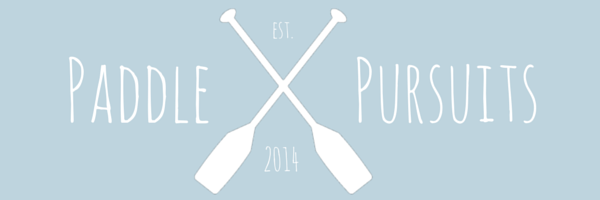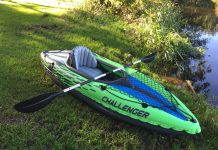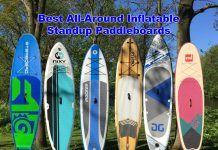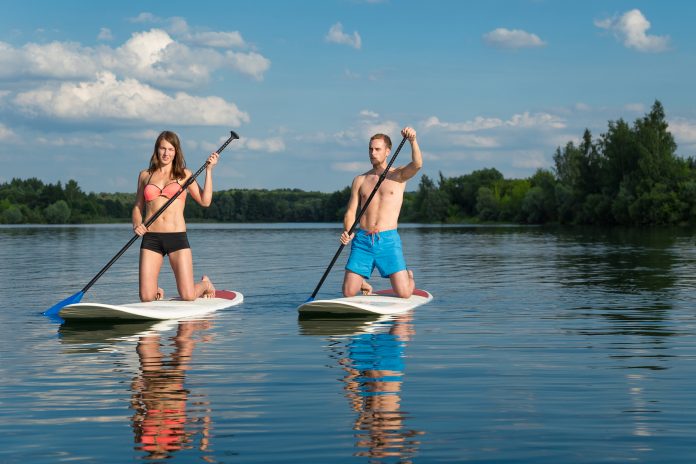
As an Amazon Associate, we earn from qualifying purchases. This is without any additional costs for the buyer but does support us in maintaining our website.
Take up any new hobby, and you’re bound to make a few mistakes. It’s part of the learning process. Making mistakes is no big deal, but it can make you look and feel a little silly.
In today’s post, we’re going to save you from embarrassment by highlighting the eight most commonly made mistakes new standup paddleboard riders make. So before you start reading our best beginner inflatable paddleboard guide, you should continue to read this article!
-
Are You Deep Enough?
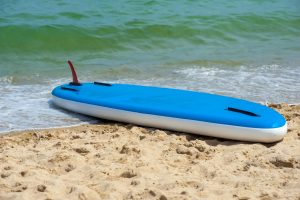 Possibly from the pure excitement of getting into the water with their SUP for the first time or not realizing how long the board actually is, many first-time riders try to jump on their board before it’s fully submerged. Doh!
Possibly from the pure excitement of getting into the water with their SUP for the first time or not realizing how long the board actually is, many first-time riders try to jump on their board before it’s fully submerged. Doh!
This isn’t much of an issue if you’re mounting on a sandy beach as your fin is only going to get wedged into the sand. But if you’re on rock, you risk SNAPPING YOUR FIN!
Avoid this amateur blunder by wading out until the water is knee high and your board is floating before mounting.
-
Trying to Leap On Like a Surfer
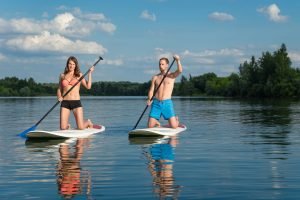 Even if your balance matches that of a professional tightrope walker, avoid the temptation to jump on your board feet first. Mount your board in the low stance (on your knees) to save yourself the embarrassment of an epic fail.
Even if your balance matches that of a professional tightrope walker, avoid the temptation to jump on your board feet first. Mount your board in the low stance (on your knees) to save yourself the embarrassment of an epic fail.
The correct way to mount is to grab the edges of the board with your hands to steady it, and then lift one knee at a time onto the middle of the board. Position your knees a couple of inches from the edge of the board for maximum stability.
Once on, paddle while kneeling or sit back on your calves – whichever is more comfortable for you.
-
Being a One Grip Pony
 The high stance (on your feet) and low stance (on your knees) require you to hold the paddle at different locations to paddle effectively.
The high stance (on your feet) and low stance (on your knees) require you to hold the paddle at different locations to paddle effectively.
When you’re paddling on your knees, grip the paddle shaft near the center with your lead hand and nearer the blade with your support hand. Holding it at the T-bar like you do when in high stance will result in big, arching strokes that will have you spinning in circles.
-
Look Down and You’ll Fall Down
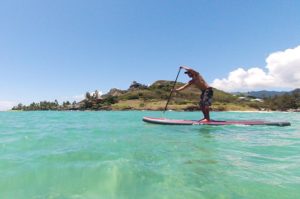
Beginners often make the mistake of staring down at the board as they try to stand. But where you look is where you go. If you’re looking down as you transition to high stance, guess where you’ll end up?
Yup, either back down on your knees or taking a tumble overboard. Instead, keep focused in front of you and rise up confidently in one fluid motion.
If you’re still struggling to get to your feet, then check out our article on how to get on a paddleboard for some more tips.
-
The T-rex Grip
Holding the SUP paddle with a narrow, Tyrannosaurus Rex grip will make it harder to balance and to put power into your strokes.
The correct grip requires one hand on the handle and the other just wider than shoulders width apart (about half way down the shaft for most people).
Here’s a test: If you’re holding your paddle at the correct grip height, your arms should be at right angles when you hold the paddle above you and the shaft touches the top of your head.
-
Pay Attention to the Blade
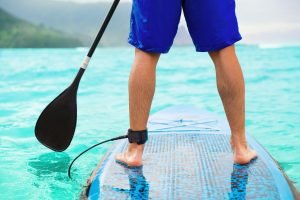 There are a few mistakes beginners make when it comes to blade positioning. The biggest blunder is holding the paddle with the blade facing the wrong way. Of course, that wouldn’t be you, right? 😉
There are a few mistakes beginners make when it comes to blade positioning. The biggest blunder is holding the paddle with the blade facing the wrong way. Of course, that wouldn’t be you, right? 😉
The proper way to hold the paddle is for the inside face of the curve to be facing you. If you hold the paddle cup side up, each stroke will be a drag and you’ll quickly drain of energy.
Also, make sure to completely submerge the blade with each stroke. You won’t be able to thrust off the water using only half a blade.
And lastly, remember to keep the paddle tight to the board. The further away from the board your strokes are, the more you’ll turn. Long strokes from top to bottom running parallel with the board will keep you travelling straight.
-
Standing Off-center
Incorrect feet positioning will make it harder to balance and also create unnecessary resistance. Stand too far back, and your nose will ride up and your board will struggle through the water. Lean too far forward, and your nose will want to break the surface and your speed and balance will be affected.
Get your stance right by planting yourself in the middle of the board with your feet 1-2 inches from the edge and with your toes pointing forward.
-
Going with the Wind
Okay, so you’re on your board and paddling. Now what?
If you’re paddling in windy conditions, my advice is to paddle into the wind first. Yes, it’s more difficult, but you want to paddle against the wind when you have the most energy. If you’ve not built-up paddling muscles yet, a strong wind can completely empty the tank.
Wrapping Up
Almost everyone makes some or even all of these mistakes in the beginning, so don’t feel bad if you’re guilty of a few. It takes time to get good at anything and learning to SUP is no exception.
By being aware of these beginner mistakes, you’ll hopefully be able to bypass them and get to the stage of being efficient, comfortable and safe on a SUP in no time at all.
Now you know the common mistakes made by SUP beginners you can read our buying guide for your first inflatable standup paddleboard!
Once you’re familiar with all the beginner tricks of paddle boarding, you can think of surfing with your SUP (how to surf paddleboard 101), or start doing yoga on your paddleboard.
But if you’re looking for more beginner SUP tips, then I recommend checking out the below video brought to you by SUP TV.
